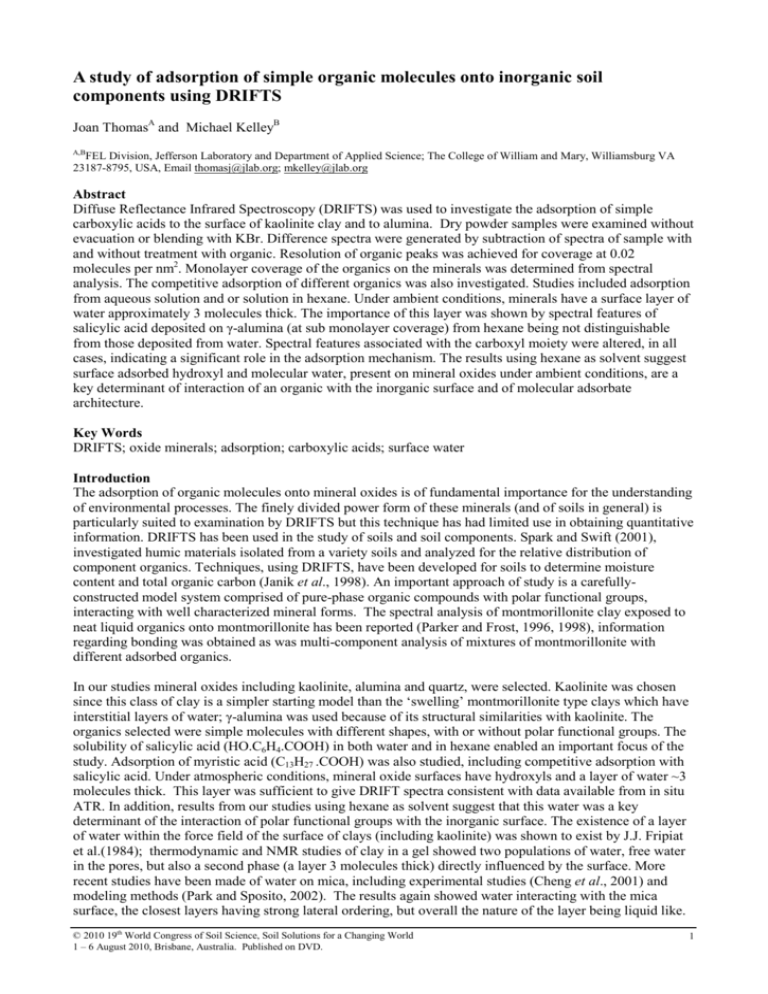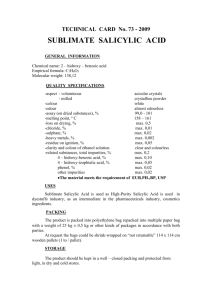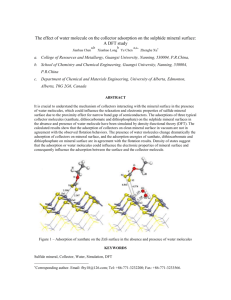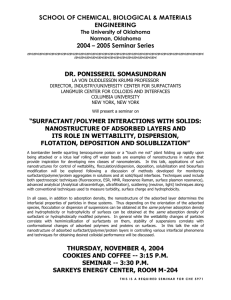A study of adsorption of simple organic molecules onto inorganic
advertisement

A study of adsorption of simple organic molecules onto inorganic soil components using DRIFTS Joan ThomasA and Michael KelleyB A,B FEL Division, Jefferson Laboratory and Department of Applied Science; The College of William and Mary, Williamsburg VA 23187-8795, USA, Email thomasj@jlab.org; mkelley@jlab.org Abstract Diffuse Reflectance Infrared Spectroscopy (DRIFTS) was used to investigate the adsorption of simple carboxylic acids to the surface of kaolinite clay and to alumina. Dry powder samples were examined without evacuation or blending with KBr. Difference spectra were generated by subtraction of spectra of sample with and without treatment with organic. Resolution of organic peaks was achieved for coverage at 0.02 molecules per nm2. Monolayer coverage of the organics on the minerals was determined from spectral analysis. The competitive adsorption of different organics was also investigated. Studies included adsorption from aqueous solution and or solution in hexane. Under ambient conditions, minerals have a surface layer of water approximately 3 molecules thick. The importance of this layer was shown by spectral features of salicylic acid deposited on γ-alumina (at sub monolayer coverage) from hexane being not distinguishable from those deposited from water. Spectral features associated with the carboxyl moiety were altered, in all cases, indicating a significant role in the adsorption mechanism. The results using hexane as solvent suggest surface adsorbed hydroxyl and molecular water, present on mineral oxides under ambient conditions, are a key determinant of interaction of an organic with the inorganic surface and of molecular adsorbate architecture. Key Words DRIFTS; oxide minerals; adsorption; carboxylic acids; surface water Introduction The adsorption of organic molecules onto mineral oxides is of fundamental importance for the understanding of environmental processes. The finely divided power form of these minerals (and of soils in general) is particularly suited to examination by DRIFTS but this technique has had limited use in obtaining quantitative information. DRIFTS has been used in the study of soils and soil components. Spark and Swift (2001), investigated humic materials isolated from a variety soils and analyzed for the relative distribution of component organics. Techniques, using DRIFTS, have been developed for soils to determine moisture content and total organic carbon (Janik et al., 1998). An important approach of study is a carefullyconstructed model system comprised of pure-phase organic compounds with polar functional groups, interacting with well characterized mineral forms. The spectral analysis of montmorillonite clay exposed to neat liquid organics onto montmorillonite has been reported (Parker and Frost, 1996, 1998), information regarding bonding was obtained as was multi-component analysis of mixtures of montmorillonite with different adsorbed organics. In our studies mineral oxides including kaolinite, alumina and quartz, were selected. Kaolinite was chosen since this class of clay is a simpler starting model than the ‘swelling’ montmorillonite type clays which have interstitial layers of water; γ-alumina was used because of its structural similarities with kaolinite. The organics selected were simple molecules with different shapes, with or without polar functional groups. The solubility of salicylic acid (HO.C6H4.COOH) in both water and in hexane enabled an important focus of the study. Adsorption of myristic acid (C13H27 .COOH) was also studied, including competitive adsorption with salicylic acid. Under atmospheric conditions, mineral oxide surfaces have hydroxyls and a layer of water ~3 molecules thick. This layer was sufficient to give DRIFT spectra consistent with data available from in situ ATR. In addition, results from our studies using hexane as solvent suggest that this water was a key determinant of the interaction of polar functional groups with the inorganic surface. The existence of a layer of water within the force field of the surface of clays (including kaolinite) was shown to exist by J.J. Fripiat et al.(1984); thermodynamic and NMR studies of clay in a gel showed two populations of water, free water in the pores, but also a second phase (a layer 3 molecules thick) directly influenced by the surface. More recent studies have been made of water on mica, including experimental studies (Cheng et al., 2001) and modeling methods (Park and Sposito, 2002). The results again showed water interacting with the mica surface, the closest layers having strong lateral ordering, but overall the nature of the layer being liquid like. © 2010 19th World Congress of Soil Science, Soil Solutions for a Changing World 1 – 6 August 2010, Brisbane, Australia. Published on DVD. 1 The special properties of the innermost layers extended to about 0.4 nm. The DRIFT technique used in our studies [Thomas and Kelley, 2008, 2009] gave spectra which were analyzed to provide quantitative information in addition to qualitative information as to structure and bonding. DRIFT spectra were taken using samples neat (without mixing with KBr). For each sample, the spectrum of the adsorbed organic was highlighted by computing a difference spectrum of the mineral treated with organic and that of a mineral sample treated as in the same manner but without the organic (mineral “blank”). The use of samples without dilution with KBr allowed greater sensitivity as to the presence of adsorbed organic and eliminated the problem of a consistent distribution of sample in the KBr mix in achieving quantitative analysis. Method Sample preparation: Full details can be found in Thomas and Kelley (2008; 2009). To achieve approximately equal surface areas for each, 1.0 g of γ-alumina and 2.0 g of kaolinite were used giving an area of 53± 1 m2. For adsorption from aqueous solution, weighed samples of organic were dissolved in 0.1 M sodium perchlorate solution (prepared using purified water) to provide a consistent high ionic background . The pH was left at that generated by the solute. The pH of the corresponding ‘blank’ was adjusted to match the sample. Samples were also prepared using hexane as the solvent. The hexane blanks were checked for residual solvent after a 24 h drying period, by examining the 3000 – 2700 cm-1 region for aliphatic carbon peaks. The samples were prepared and stored in glass vials or flasks and covered with foil to exclude light. Selected samples with excess organic remaining in solution were set aside and the solvent was permitted to evaporate (‘dried-down’). Samples for the study of competitive adsorption of salicylic and myristic acid were prepared such that each treating solution contained the same molar quantity of each organic. Spectroscopy: In preparation for DRIFTS, samples were added to the cup with no dilution with KBr. Spectra were collected using a Nicolet NEXUS 670 spectrometer fitted with a SPECTRA-TECH “COLLECTOR II”, DRIFTS unit purged with air passed through a “BALSTON” air drier. The number of scans was set at 100 with a resolution of 4 cm-1, over the range 4000 – 600 cm-1. The aperture setting was 100 and the scan velocity 0.158 minutes per scan. These settings maximize the collection of the IR radiation but allow for a spectral resolution of 4 cm-1. There was no use of automatic corrections. Quantitative analysis of DRIFT spectra required the use of Kubelka-Munk (KM) units in the graphical format calculated by instrument software from the recorded % transmission (Smith, 1996). Spectra of the materials treated with organic and the prepared blank were both collected against a KBr background spectrum. Changes to the surface due to the organic were highlighted by a “difference spectrum”, the spectrum of the organic treated mineral minus the spectrum of the mineral blank, computed by simple subtraction. When displaying multiple spectra baseline correction may have been performed and this is noted in the caption. Selected peaks were baseline corrected for determination of the peak height. Results Qualitative information as to bonding -C H 2 -C OO Intensity (KM) C-C ring Phenolic -OH -C = O -C H 2 -COO -C O O 1700 1600 1500 1400 1300 Wavenumbers (cm-1) 1200 (a) 30 00 2 600 2200 180 0 140 0 W a v e n u m b e rs ( c m - 1 ) (b) Figure 1. (a): Difference spectra for γ-alumina treated with salicylic acid (spectra both shown full scale and with displacement). UPPER (displaced, scale -1.0-2.2 KM) sample treated with excess salicylic acid and unwashed. LOWER- (scale 0-6 KM) washed sample. (b) DRIFT subtraction spectra of myristic acid adsorbed onto: kaolinite (grey, displaced, scale 0 – 1.0 KM); γ-alumina (black, scale 0-12 KM). © 2010 19th World Congress of Soil Science, Soil Solutions for a Changing World 1 – 6 August 2010, Brisbane, Australia. Published on DVD. 2 Quantitative information (b) (a) Figure 2. Correlation of carboxylate (‘X’ peak at 1382 cm-1) and phenol group (‘♦’peak at1263 cm-1) peak height with available molecules of salicylic acid in solution (a) and adsorbed (b) as determined by changes in solution concentration. (i) Figure 3. Spectra of γ-alumina with adsorbed salicylic acid from hexane solution. (Black) maximum loading for adsorption from hexane (~3.0 molecules /nm2); (grey) same sample with an additional short water rinse; (bold grey) same sample with 36 h water wash; (bold black dashed) sample prepared with an aqueous solution with analysis showing 0.7 molecules / nm2 adsorbed. 20 KM 10 0 1800 1700 1 600 1500 W a v e n u m b e rs ( c m 1400 -1 1300 ) Competitive adsorption (a) (b) Figure 4(a): Variation in the height of the peak at 2926 cm-1, arising from the alkyl chain, with the exposure of kaolinite samples to myristic acid in hexane either as the sole component or in combination with an equal quantity of salicylic acid. 4(b): Variation in the height of the peak at 1476 cm-1, arising from the aromatic ring, with the exposure of kaolinite samples to salicylic acid in hexane either as the sole component or in combination with an equal quantity of myristic acid (corrected was made for the contribution of myristic acid at this wavenumber). Conclusions The DRIFT technique used in our studies (Thomas and Kelley, 2008; 2009) gave spectra providing quantitative information (Figure 2) in addition to qualitative information (Figure 1) as to structure and bonding. The use of samples without dilution with KBr allowed greater sensitivity in detecting adsorbed organic and eliminated the problem of a consistent distribution of sample in the KBr mix in achieving quantitative analysis. The density of monolayer coverage of molecules adsorbed onto the mineral oxides was © 2010 19th World Congress of Soil Science, Soil Solutions for a Changing World 1 – 6 August 2010, Brisbane, Australia. Published on DVD. 3 determined and detection limits of the order of 1-10 molecules per 100 nm2 for γ-alumina were achieved. Adsorption of salicylic acid from aqueous solution onto γ- alumina was as carboxylate, together with evidence of interaction of the phenol group with the surface. Of particular note was that when using hexane as the solvent, adsorption of salicylic and myristic acid as the carboxylate again occurs, indicating that the surface hydroxyl groups and adsorbed water strongly influence the interaction of the polar groups with the surface. There was no clear evidence of the carbonyl group on the surface of either mineral for the hexane washed samples. The maximum loading of salicylic acid adsorbed onto γ- alumina and kaolinite, was in the range of 2 - 4 molecules /nm2 when hexane was used as the solvent compared with 0.1 – 0.7 molecules /nm2 for aqueous solution. Water washing the samples prepared with hexane decreased the coverage to the maximum level observed with adsorption from aqueous solution. In the case of γ- alumina, adsorption of the organic above the maximum level observed with aqueous solution was accompanied by new peaks for the ring and each of the functional groups. These were the peaks removed by water washing. The position of the phenol group for organic adsorbed to these sites indicated less hydrogen bonding with the surface. The ready removal of this extra material with water also indicated a weaker interaction of the carboxylate group with the surface. These observations support hexane allowing adsorption onto the same set of sites accessible from aqueous solution and, when these are all occupied, allowing interaction with other less favourable sites. The results of quantitative studies using hexane as the solvent, were used as calibration in the study of the competitive adsorption of salicylic and myristic acids onto γ-alumina and kaolinite. Peaks unique to the ring or the chain were selected for analysis. The surface loading of salicylic acid was not influenced by the presence of myristic acid on either mineral but the maximum loading of myristic acid was decreased (46 - 50 %) by salicylic acid. A 25 % increase in the maximum loading was observed for kaolinite, but not for γalumina. Displacement of myristic acid from γ-alumina, but not kaolinite, was observed when excess salicylic acid remained in solution. On γ-alumina, after a loading of 1 molecule per nm2, increased exposure resulted in salicylic acid adsorption only, this value being approximately the same as for salicylic acid adsorption from aqueous solution or for water washed hexane treated samples. Thus a set of sites for adsorption of either acid is indicated together with other energetically less favourable sites, which can be occupied by salicylic, but not by myristic, acid. References Cheng L, Fenter P, Nagy KL, Schlegel ML, Sturchio NC (2001) Molecular-scale density oscillations in water adjacent to a mica surface. Phys. Rev. Lett. 87-15, 156103. Fripiat JJ, Letellier M, Levitz P (1984) Interaction of water with clay surfaces. Phil. Trans. R. Soc. Lond. A. 311, 287-299. Janik LJ, Merry RH, Skjemstad JO (1998) Can mid infrared diffuse reflectance analysis replace soil extractions, Australian Journal of Experimental Agriculture, 38, 681. Park S-Ho, Sposito G (2002) Structure of water adsorbed on a mica surface. Phys. Rev Lett. 89-8, 085501 Smith BC (1996) Fundamentals of Fourier Transform Infrared Spectroscopy, CRC Press, Boca Raton FL. Parker RW, Frost RL (1996) The application of DRIFT spectroscopy to the multicomponent analysis of organic chemicals adsorbed on montmorillonite, Clays and Clay Minerals, 44-1, 32-40. Parker RW, Frost RL (1998) Monitoring the sorption of propanoic acid by montmorillonite using diffuse reflectance Fourier transform infrared spectroscopy, Fourier Transform Spectroscopy:11th International Conference, J.A.de Haseth (Ed), The American Institute of Physics 1-56396-746-4/98. Spark KM, Swift RS (2001) Analysis of the molecular weight fractions of a soil humic acid using DRIFT spectroscopy. In, Understanding and Managing Organic Matter in Soils, Sediments and Waters, R.S. Swift and K.M. Spark (Eds) IHSS. Thomas JE, Kelley MJ (2008) Interaction of mineral surfaces with simple organic molecules by diffuse reflectance IR spectroscopy (DRIFT). J. Colloid Interface Sci. 322-2, 516. Thomas JE, Kelley MJ (2009) The adsorption of salicylic acid onto γ-alumina and kaolinite from solution in hexane studied using diffuse reflectance IR spectroscopy (DRIFT). J. Colloid Interface Sci. 338-2, 389. Thomas JE, Kelley MJ (2009 submitted) A study of competitive adsorption of organic molecules onto mineral oxides using DRIFTS. J. Colloid Interface Sci. © 2010 19th World Congress of Soil Science, Soil Solutions for a Changing World 1 – 6 August 2010, Brisbane, Australia. Published on DVD. 4








